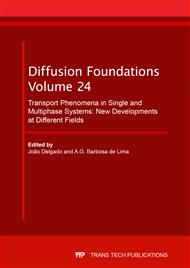[1]
Flannigan, Brian, et al. Health implications of fungi in indoor environments-an overview. Health implications of fungi in indoor environments, 1994, 2: 3-28.
Google Scholar
[2]
Koskinen, O. M., et al. The relationship between moisture or mould observations in houses and the state of health of their occupants. European Respiratory Journal, 1999, 14.6: 1363-1367.
DOI: 10.1183/09031936.99.14613639
Google Scholar
[3]
Armstrong, Sarah. The fundamentals of Fungi. ASHRAE journal, 2002, 44.11: 18.
Google Scholar
[4]
Turner, Fred. Moisture and mold. ASHRAE Journal, 2002, 44.11: 4.
Google Scholar
[5]
Handbook, ASHRAE, et al. American Society of Heating. Refrigeration and Air-Conditioning Engineers, Inc, (2001).
Google Scholar
[6]
Küntz, M.; Lavallée, P. Experimental evidence and theoretical analysis of anomalous diffusion during water infiltration in porous building materials. Journal of Physics D: Applied Physics, 2001, 34.16: 2547.
DOI: 10.1088/0022-3727/34/16/322
Google Scholar
[7]
Woodside, W. Calculation of the thermal conductivity of porous media. Canadian Journal of Physics, 1958, 36.7: 815-823.
DOI: 10.1139/p58-087
Google Scholar
[8]
N. Mendes and P.C. Philippi (2005), P.C., A method for predicting heat and moisture transfer through multilayer walls based on temperature and moisture content gradients. International Journal of Heat and Mass Transfer, 48, 37–51.
DOI: 10.1016/j.ijheatmasstransfer.2004.08.011
Google Scholar
[9]
M. Bomberg (1974), Moisture Flow Through Porous Building Materials, Division of Building Technology, Lund Institut of Technology, Lund, Sweden, Report nº 52.
DOI: 10.2136/sssaj1975.03615995003900020004x
Google Scholar
[10]
H. Janssen, H. Derluyn, J. Carmeliet. Moisture Transfer Through Mortar Joints: A Sharp-Front Analysis. Cem. Concr. Res. 42 (2012) 1105-1112. https://doi.org/10.1016/j.cemconres.2012.05.004.
DOI: 10.1016/j.cemconres.2012.05.004
Google Scholar
[11]
P. Mukhopadhyaya, P. Goudreau, K. Kumaran, N. Normandin, Effect of Surface Temperature on Water Absorption Coefficient of Building Materials, J. Therm. Envelope Build. Sci. 26 (2002) 179-195, ttps://doi.org/10.1177/0075424202026002974.
DOI: 10.1177/0075424202026002974
Google Scholar
[12]
Roels, S. et al (2004). Interlaboratory Comparison of Hygric Properties of porous building materials,, In Journal of Thermal Environment and Building, vol. 27, nº 4.
Google Scholar
[13]
García, N. A. et al (2012). Propiedades físicas y mecánicas de ladrillos macizos cerámicos para mampostería,, In Ciencia y Ingeniería Neogranadina, vol.22-1 (pp.: 43-58).
DOI: 10.18359/rcin.248
Google Scholar
[14]
V.P. Freitas, Moisture transfer in building walls – Interface phenomenon analyse, PhD Thesis; Faculty of Engineering, University of Porto, Porto, Portugal, (1992).
Google Scholar
[15]
P. Crausse, Fundamental study of heat and moisture transfer in unsaturated porous medium, PhD thesis, ENSEEIHT, Toulouse, (1983).
Google Scholar
[16]
B. Perrin, Study of coupled heat and mass transfer in consolidated, unsaturated porous materials used in civil engineering, PhD thesis, University Paul Sabatier, (1985).
Google Scholar
[17]
V.P. Freitas, V. Abrantes, P. Crausse. Moisture migration in building walls – Analysis of interface phenomena. Build Environ 1996;31:99-108.
DOI: 10.1016/0360-1323(95)00027-5
Google Scholar
[18]
Bear, J. and Bachmat, Y. Introduction to Modeling of. Transport Phenomena in Porous Media, 1990, 305.
Google Scholar
[19]
Lanzinha, J.C.G. Propriedades higrotérmicas de materiais de construção. 1998. Master's Thesis. Departamento de Engenharia Civil.
Google Scholar
[20]
ISO (2002). Hygrothermal Performance of Building Materials and Products. Determination of Water Absorption Coefficient by Partial Immersion. ISO 15148. Geneva. Switzerland: International Organization for Standardization.
DOI: 10.3403/02801954u
Google Scholar
[21]
Nielsen, A. (1972). Gamma-ray – attenuation used for measuring the moisture content and homogeneity of porous concrete, In Building SCI, Vol. 7. (pp.: 257-263).
DOI: 10.1016/0007-3628(72)90007-2
Google Scholar
[22]
Kumaran, M. K.; Bomberg, M. A gamma-spectrometer for determination of density distribution and moisture distribution in building materials. National Research Council Canada. Division of Building Research, (1985).
Google Scholar
[23]
Kumaran, M. K., et al. Moisture transport coefficient of pine from gamma ray absorption measurements. In: ASME Heat Transfer Division. 1989. pp.179-183.
Google Scholar
[24]
F. Descamps. Continuum and discrete modelling of isothermal water and air transfer in porous media. Ph.D. Thesis, Catholic University of Leuven, Leuven, (1997).
Google Scholar
[25]
Philip, J.-R. Theory of infiltration. In: Advances in hydroscience. Elsevier, 1969. pp.215-296.
Google Scholar
[26]
Philip, J. R.; De Vries, D. A. Moisture movement in porous materials under temperature gradients. Eos, Transactions American Geophysical Union, 1957, 38.2: 222-232.
DOI: 10.1029/tr038i002p00222
Google Scholar
[27]
Neter, John, et al. Applied linear statistical models. Chicago: Irwin, (1996).
Google Scholar
[28]
Chou, Jui-Sheng; PHAM, Anh-Duc. Enhanced artificial intelligence for ensemble approach to predicting high performance concrete compressive strength. Construction and Building Materials, 2013, 49: 554-563.
DOI: 10.1016/j.conbuildmat.2013.08.078
Google Scholar
[29]
Nunes, C., Pel, L., Kunecký, J., & Slížková, Z. (2017). The influence of the pore structure on the moisture transport in lime plaster-brick systems as studied by NMR. Construction and Building Materials. Vol 142. 395-409.
DOI: 10.1016/j.conbuildmat.2017.03.086
Google Scholar
[30]
Brocken, H.; Pel, Leo; Kopinga, K. Moisture transport over the brick/mortar interface. In: Nuclear Magnetic Resonance Spectroscopy of Cement-Based Materials. Springer, Berlin, Heidelberg, 1998. pp.397-401.
DOI: 10.1007/978-3-642-80432-8_33
Google Scholar
[31]
Shahidzadeh-Bonn, N.; Azouni, A.; Coussot, P. Effect of wetting properties on the kinetics of drying of porous media. Journal of physics: condensed matter, 2007, 19.11: 112101.
DOI: 10.1088/0953-8984/19/11/112101
Google Scholar


